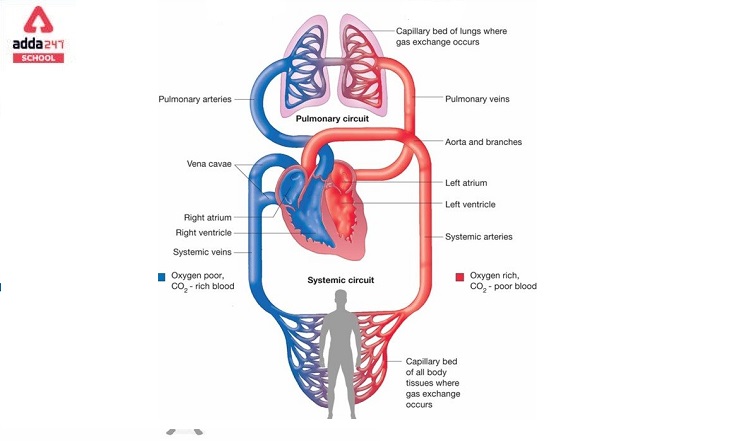Double Circulation
The human body is in itself a mystery. The way every organ and the organs system works leaves us wondering about things. Double circulation is an efficient method of blood circulation and is carried out by the circulatory system.
Let’s read and know about what circulatory system is and how is double circulation associated to it!
Read About: Autotrophic Nutrition
The circulatory system
The circulatory system transports nutrients and gases such as oxygen throughout the body. The circulatory system also trasfers metabolic waste products out from the body. The heart and lungs are critical for blood circulation and purification throughout the body.
There are two types of circulatory systems in animals. The circulatory system types are open circulatory and closed circulatory. A twofold circulation system is used by the majority of mammals, including humans.
Based on the number of times blood circulates through the heart, the closed circulatory system is further divided into two types:
Single Circulation
In a single circulatory system, blood travels from the heart to the gills, where it is purified before being dispersed to various areas of the body. The moniker “single circulation” comes from the fact that just one heart cycle is completed. Birds, fish, reptiles, and other animals with single circulation are the most common.
Double Circulation
The heart is the most important organ for blood circulation, and twofold circulation is a good way to circulate blood since it is efficient. The key distinction is that blood travels in two directions: one for oxygenated blood and another for deoxygenated blood. As a result, the term “double circulation” was coined. A twofold circulation system is used by the majority of mammals, including humans.
Furthermore, the pulmonary artery and vein connect the heart to the lungs. There are two channels through which blood flows in double circulation. They are as follows:
Systemic circulation
The left ventricles send oxygenated blood to the tissue capillaries via systemic circulation.
Pulmonary circulation
Blood circulates from the right atrium to the left atrium in the pulmonary circulation.
Both oxygenated and deoxygenated blood are kept separate by double circulation. As a result, this circulation guarantees that the body has a constant supply of oxygen while also increasing body efficiency. One of the reasons mammals can maintain their body temperatures is because of this. A third portal mechanism, in addition to double circulation, exists to boost circulation efficiency.
Read About: Permanent Tissues
Define Double Circulation in Hindi
मानव शरीर अपने आप में एक रहस्य है। जिस तरह से हर अंग और अंग प्रणाली काम करती है, वह हमें चीजों के बारे में सोचने पर मजबूर कर देती है। दोहरा परिसंचरण रक्त परिसंचरण का एक कुशल तरीका है और संचार प्रणाली द्वारा किया जाता है।
आइए पढ़ें और जानें कि परिसंचरण तंत्र क्या है और इससे दोहरा परिसंचरण कैसे जुड़ा है!
संचार प्रणाली
संचार प्रणाली पूरे शरीर में ऑक्सीजन जैसे पोषक तत्वों और गैसों का परिवहन करती है। संचार प्रणाली भी शरीर से चयापचय अपशिष्ट उत्पादों को बाहर निकालती है। हृदय और फेफड़े पूरे शरीर में रक्त परिसंचरण और शुद्धिकरण के लिए महत्वपूर्ण हैं।
जंतुओं में दो प्रकार के परिसंचरण तंत्र होते हैं। संचार प्रणाली प्रकार खुले परिसंचरण और बंद परिसंचरण हैं। मनुष्यों सहित अधिकांश स्तनधारियों द्वारा एक दुगनी परिसंचरण प्रणाली का उपयोग किया जाता है।
हृदय के माध्यम से रक्त के प्रवाह की संख्या के आधार पर, बंद संचार प्रणाली को आगे दो प्रकारों में विभाजित किया जाता है:
सिंगल सर्कुलेशन
एक एकल संचार प्रणाली में, रक्त हृदय से गलफड़ों तक जाता है, जहां इसे शरीर के विभिन्न क्षेत्रों में फैलाने से पहले शुद्ध किया जाता है। मोनिकर “सिंगल सर्कुलेशन” इस तथ्य से आता है कि सिर्फ एक हृदय चक्र पूरा होता है। पक्षी, मछली, सरीसृप और एकल परिसंचरण वाले अन्य जानवर सबसे आम हैं।
दोहरा परिसंचरण
रक्त परिसंचरण के लिए हृदय सबसे महत्वपूर्ण अंग है, और दो गुना परिसंचरण रक्त को प्रसारित करने का एक अच्छा तरीका है क्योंकि यह कुशल है। मुख्य अंतर यह है कि रक्त दो दिशाओं में यात्रा करता है: एक ऑक्सीजन युक्त रक्त के लिए और दूसरा ऑक्सीजन रहित रक्त के लिए। नतीजतन, “डबल सर्कुलेशन” शब्द गढ़ा गया था। मनुष्यों सहित अधिकांश स्तनधारियों द्वारा एक दुगनी परिसंचरण प्रणाली का उपयोग किया जाता है।
इसके अलावा, फुफ्फुसीय धमनी और शिरा हृदय को फेफड़ों से जोड़ती है। दो चैनल हैं जिनके माध्यम से रक्त दोहरे परिसंचरण में बहता है। वे इस प्रकार हैं:
प्रणालीगत संचलन
बाएं निलय प्रणालीगत परिसंचरण के माध्यम से ऊतक केशिकाओं में ऑक्सीजन युक्त रक्त भेजते हैं।
पल्मोनरी परिसंचरण
फुफ्फुसीय परिसंचरण में रक्त दाएं अलिंद से बाएं आलिंद में घूमता है।
ऑक्सीजन युक्त और विऑक्सीजनित रक्त दोनों को दोहरे परिसंचरण द्वारा अलग रखा जाता है। नतीजतन, यह परिसंचरण गारंटी देता है कि शरीर की दक्षता में वृद्धि करते हुए शरीर को ऑक्सीजन की निरंतर आपूर्ति होती है। स्तनधारी अपने शरीर के तापमान को बनाए रखने के कारणों में से एक इसका कारण है। एक तीसरा पोर्टल तंत्र, दोहरे परिसंचरण के अलावा, परिसंचरण दक्षता को बढ़ावा देने के लिए मौजूद है।









 CUET History Syllabus 2026 (Updated), Do...
CUET History Syllabus 2026 (Updated), Do...
 CUET General Test Syllabus 2026 (Latest)...
CUET General Test Syllabus 2026 (Latest)...
 CUET Economics Syllabus 2026, Exam Patte...
CUET Economics Syllabus 2026, Exam Patte...














